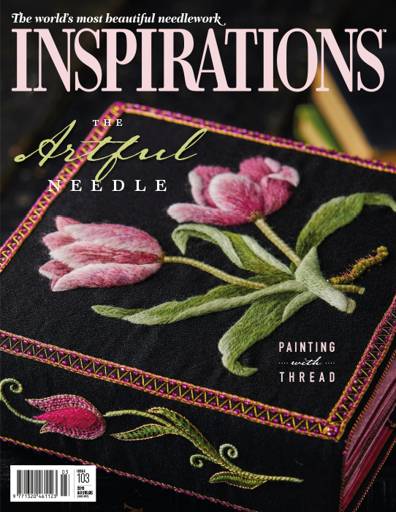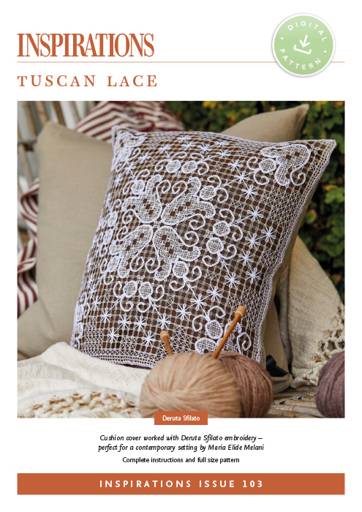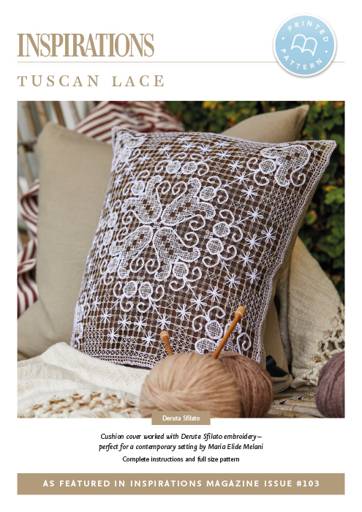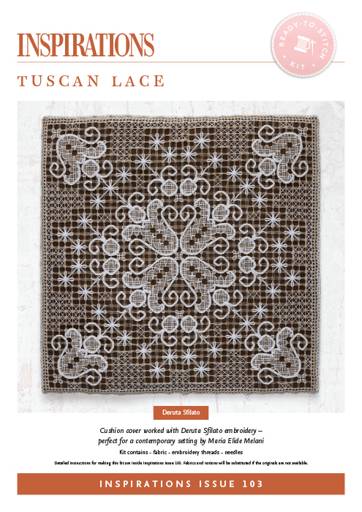Tuscan Lace by Maria Elide Melani
26TH JULY 2019 - ASU #196
Not everyone is confident enough to go at a piece of linen with a pair of scissors. I’m sure you still remember that leap of faith you had to take when trying your first piece of Hardanger embroidery and being told to cut a thread.

It wasn’t the cutting that was the biggest problem – it was remembering to breathe! But what a result after those cuts were made. The myriad patterns, designs and details that formed through the combination of thread and space, stitches and voids, was worth the anxiety.

Often, however, there is confusion between pulled thread embroidery and drawn thread embroidery. This is heightened by the fact that sometimes the term ‘drawn fabric embroidery’ has been used to describe pulled thread work. It is little wonder there is confusion.

So just to clarify, drawn thread work involves that terrifying leap of faith to remove threads from your work using scissors. Pulled thread (or drawn fabric) is work where voids and patterns are created through the tensioning of your stitches. No scissors involved!
Both drawn and pulled thread techniques require precision, and both produce stunning results, but when you combine the two, you enjoy the best of everything.
Maria Elide Melani’s Tuscan Lace project from Inspirations issue #103 is a wonderful and not too difficult introduction to both techniques, allowing you to practice both pulling and drawing your threads and resulting in a light and lacy finish that seems lighter than air.

The reason this project is wonderful for beginners is the ground linen is only 9 threads per cm. When your fabric threads are so spacious, you can be very confident that you are correctly counting which threads to cut and are then only cutting one thread at a time.

Furthermore, before you even pick up your scissors, you are eased into the project with a pulled thread, four-sided stitch border. This border allows you to form even, regular holes simply by pulling your needle and thread taut at the right point. Finally, rather than struggling with fine silks or single strands of thread, you work your piece using crochet cotton – easy to thread in your needle and easy to see.
Tuscan Lace is yet another example of how beauty can come from even the simplest of stitches.
However, don’t let the ease of the stitches fool you. The key to the success of this project is correct tension – pulling just enough where necessary, but not so much that it distorts the shape. The loosely woven linen can be as much of a curse as a blessing in this respect, so working on a frame is essential.

Maria is one of the world’s experts on this technique of Deruta Sfilato, or Deruta Drawn Thread Work, having written several books about it and worked hard to ensure the technique survives. And it is so easy to see the appeal. This project allows even the most timid of us to create lace.

Complete this piece and the scissors will no longer be an instrument to fear, but a way to create exquisite beauty.
Make Your Own Tuscan Lace

Tuscan Lace by Maria Elide Melani is a stunning cushion cover worked with Deruta Sfilato embroidery, perfect for a contemporary setting.

Printed Magazine
Inspirations Issue 103
Shop Now
Digital Pattern
Tuscan Lace - i103 Digital
Shop Now
Printed Pattern
Tuscan Lace - i103 Print
Shop NowStep 2 – Purchase Ready-To-Stitch Kit
The Inspirations Ready-To-Stitch kit for Tuscan Lace includes everything you need to re-create this beautiful cushion cover: Fabric (unprinted), embroidery threads and needles.
Special Note: Instructions are not included with this kit. Please refer to the magazine for detailed information on how to create the project.

